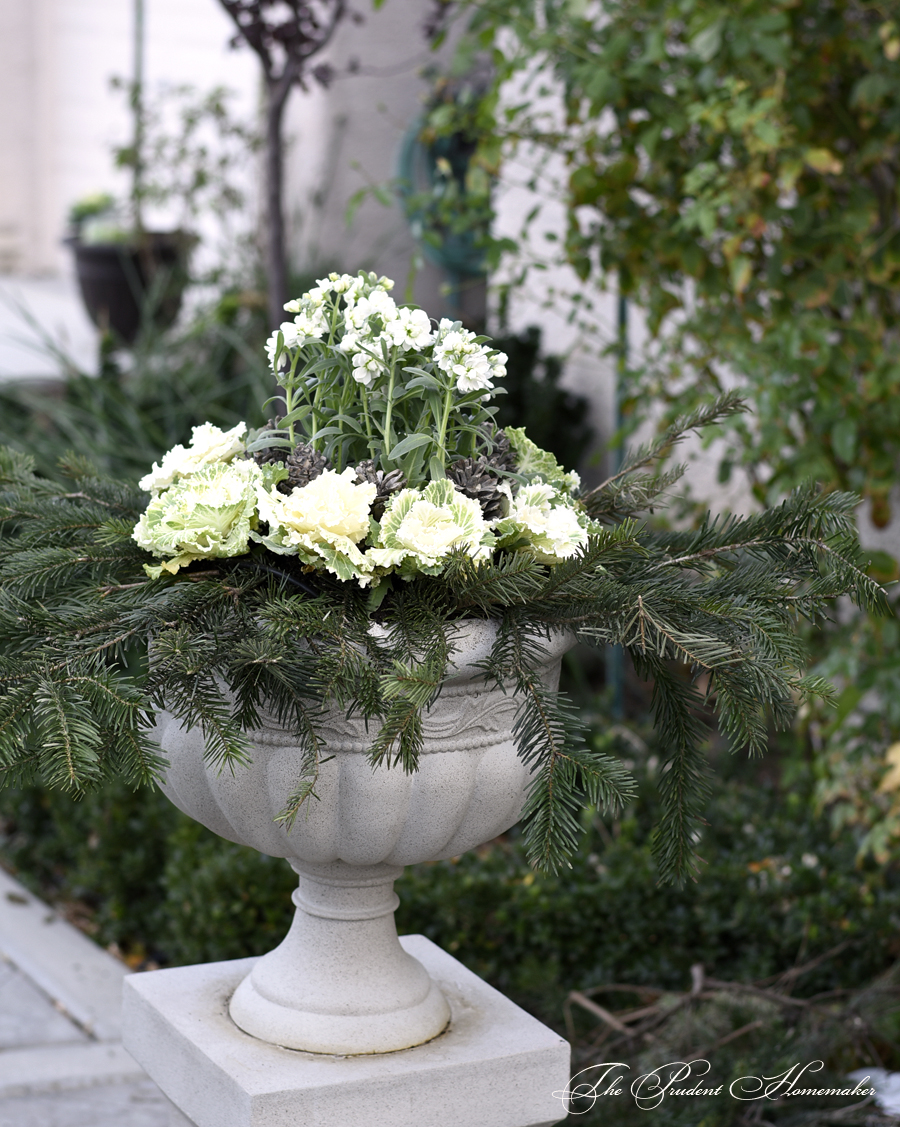
I’ve been trying a mixture of annuals and perennials in my urns in the white garden, but it seems the only way to have something growing in them year-round is to do annuals, as even my perennials have died. The pots by the front door are particularly challenging; they are in full shade all day long. The garden itself is in shade all winter, and come summer it is mostly in our brutal sun, but for much of the year, it is half in sun and half in shade.
I have been staring at beautiful urns on Pinterest (I even have a board for it) trying to decide what to do this winter that will last into spring. I know what plants do well here winter through spring, and all of them are on sale right now (and I had an additional $5 off coupon on top of that to use). I knew I wanted to use some free evergreen branches, and the nursery, which sells Christmas trees, was the place to get those too. I just hadn’t decided exactly what to do.
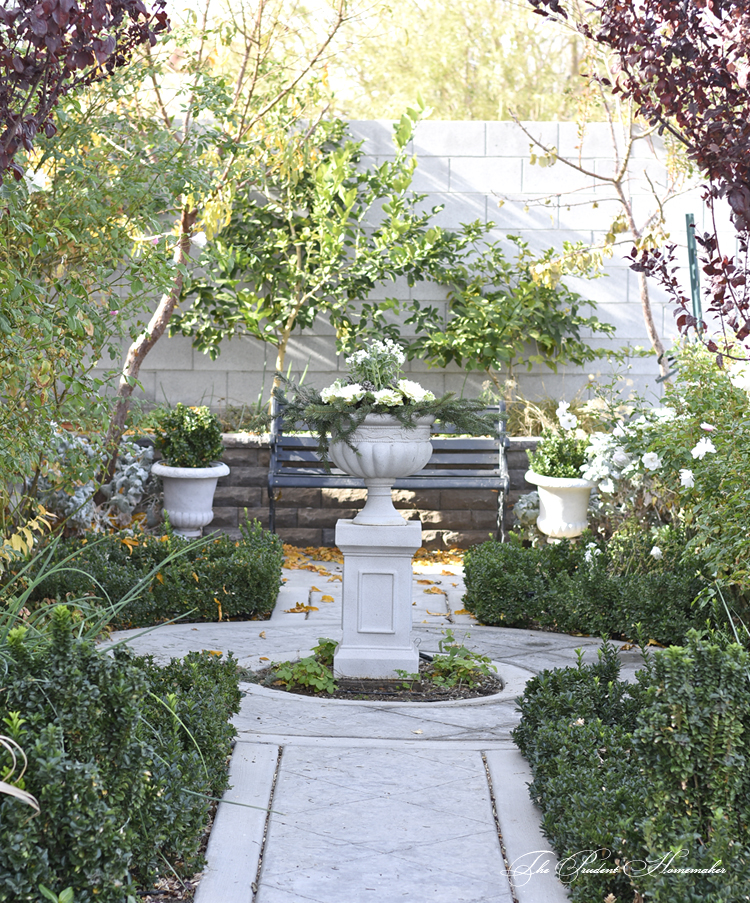
At the nursery there was a birdbath, and it was filled with flowers that looked so beautiful–and then I knew. There was a silvery small-leafed plant in the center, surrounded by a dark pinkish red cyclamen, surrounded by white ornamental cabbages. It was so pretty I seriously considered planting some red cyclamen in the garden for Christmas.
However, it’s a white garden, and I wanted something that would last until April (winter annuals here are good October through April). I loved the cyclamen, but I know they do better in the shade here (they’ll last longer in the shade when the heat comes, which is early here). I debated a change in the middle–stock or snapdragons? Both will do well; stock (what I ultimately chose for the center urn) flowers for a shorter period, but has an intense fragrance which I enjoy; snapdragons get larger and would be a less expensive option; I could just choose one or two plants if I wanted.
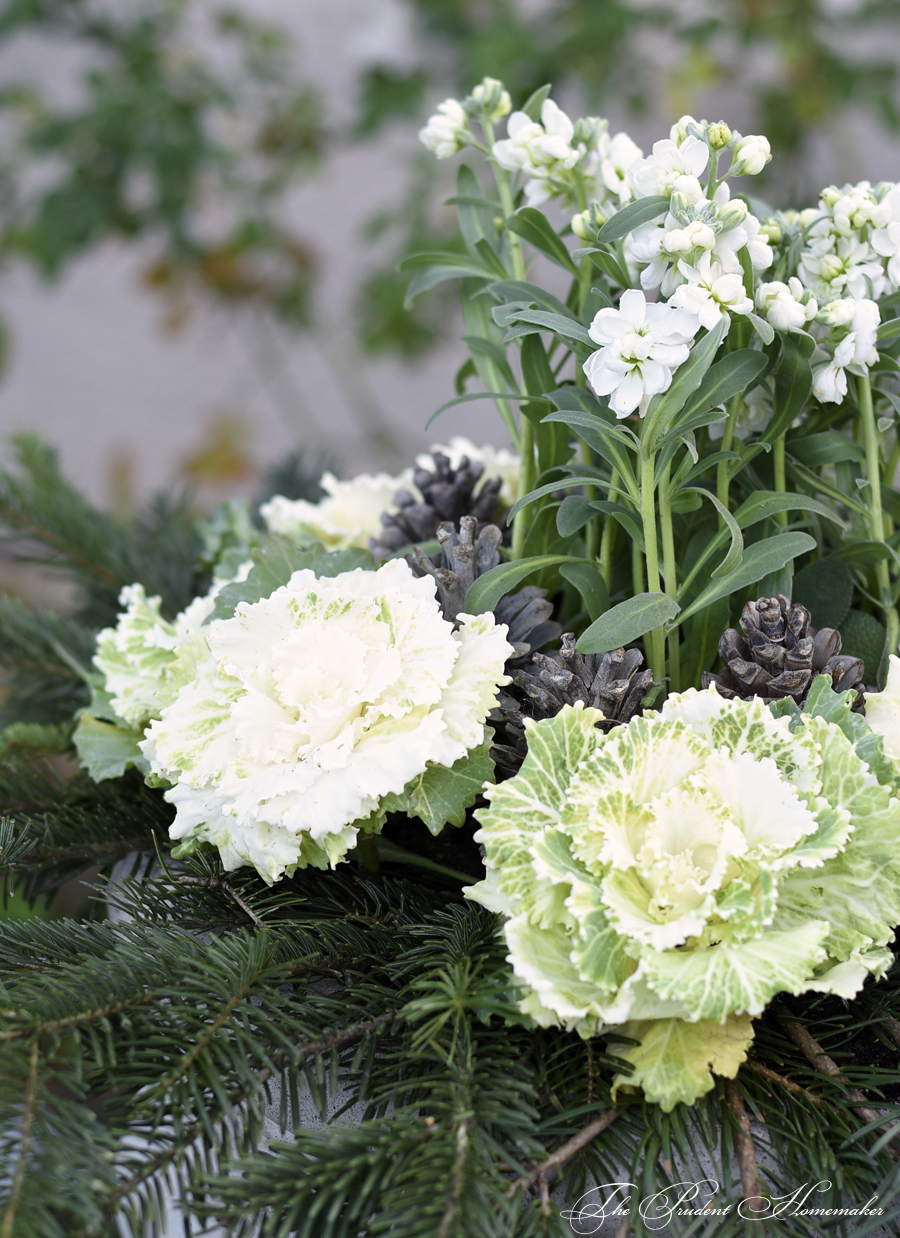
In the end, I went with sage in the middle (not noticeable at all, but a silvery-grey color that I think may work for a similar design come summer, by which time it will be larger; on sale for $0.98), surrounded by 4 stock flowers (on sale for $0.78 each), surrounded by 9 ornamental cabbage (on sale for $0.78 each). Should the cabbage grow too large before they bolt, I’ll transplant them to another spot in the garden.
I added some pinecones that we had gathered in between the stock and cabbages. I used clippers to cut the free Christmas tree branches into smaller pieces and then stuck them into the arrangement. The ends are in the moist soil, so they’ll stay good for a while (and longer if I mist them).
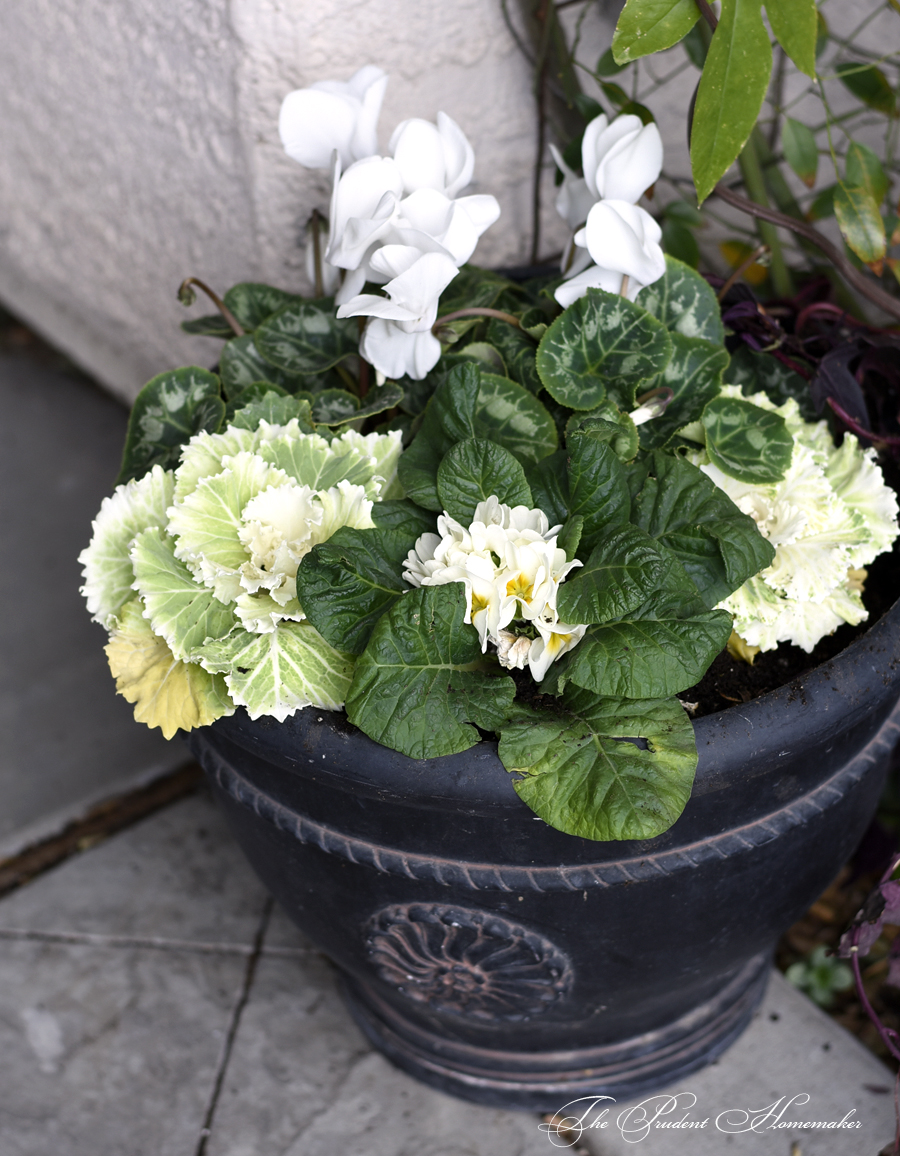
I had planned on getting some cyclamen too (on sale for $2.88 each), so I added some into the black pots by our entrance, along with more ornamental cabbage and a primrose ($1.98 each) . As I was in line at the nursery, I noticed that they had repeated the same arrangement indoors I had admired outdoors, but with purple cabbage and white cyclamen.
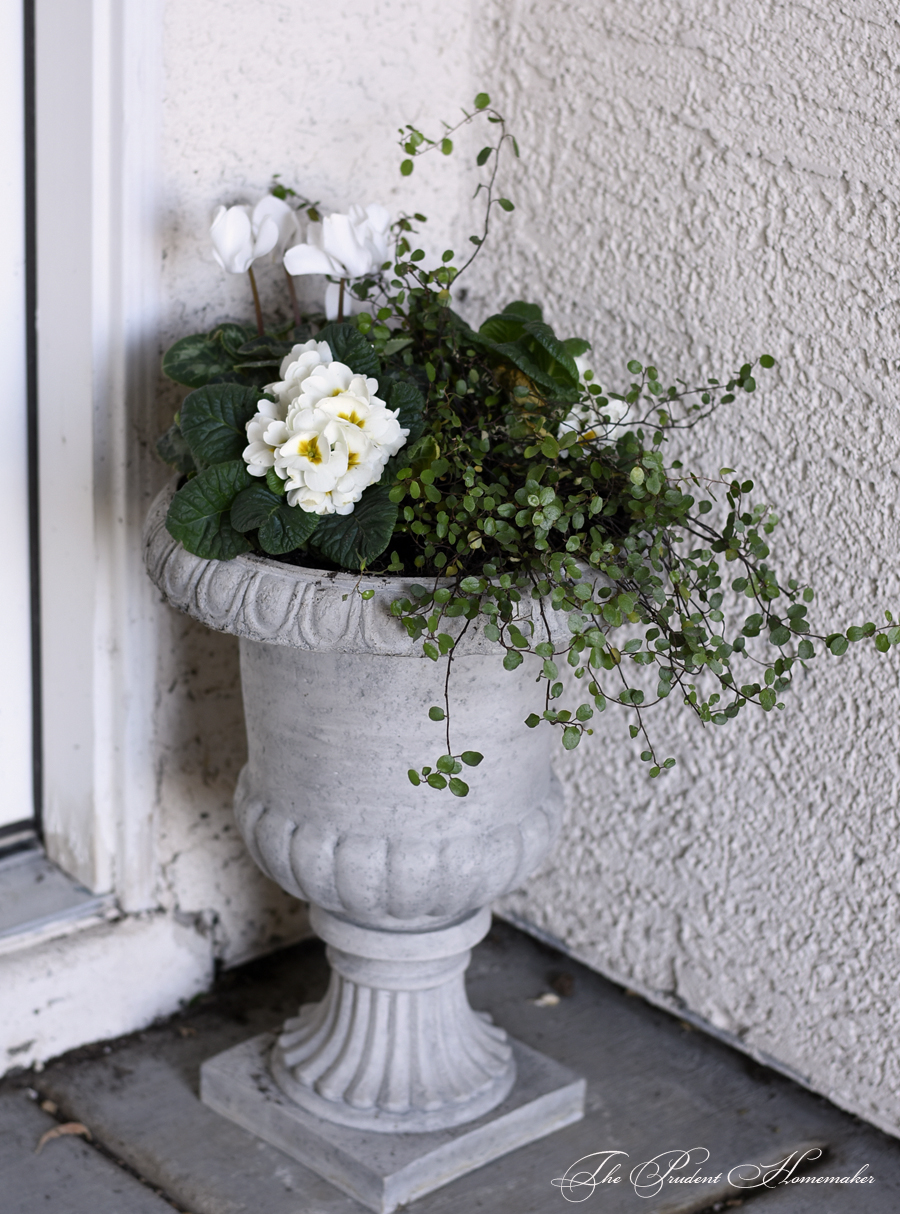
In the urns at the front door, I had added some wire vine earlier this summer. I dug in the spaces around it and put a cyclamen plant in each, along with two primroses. These won’t mind the full shade of this spot.
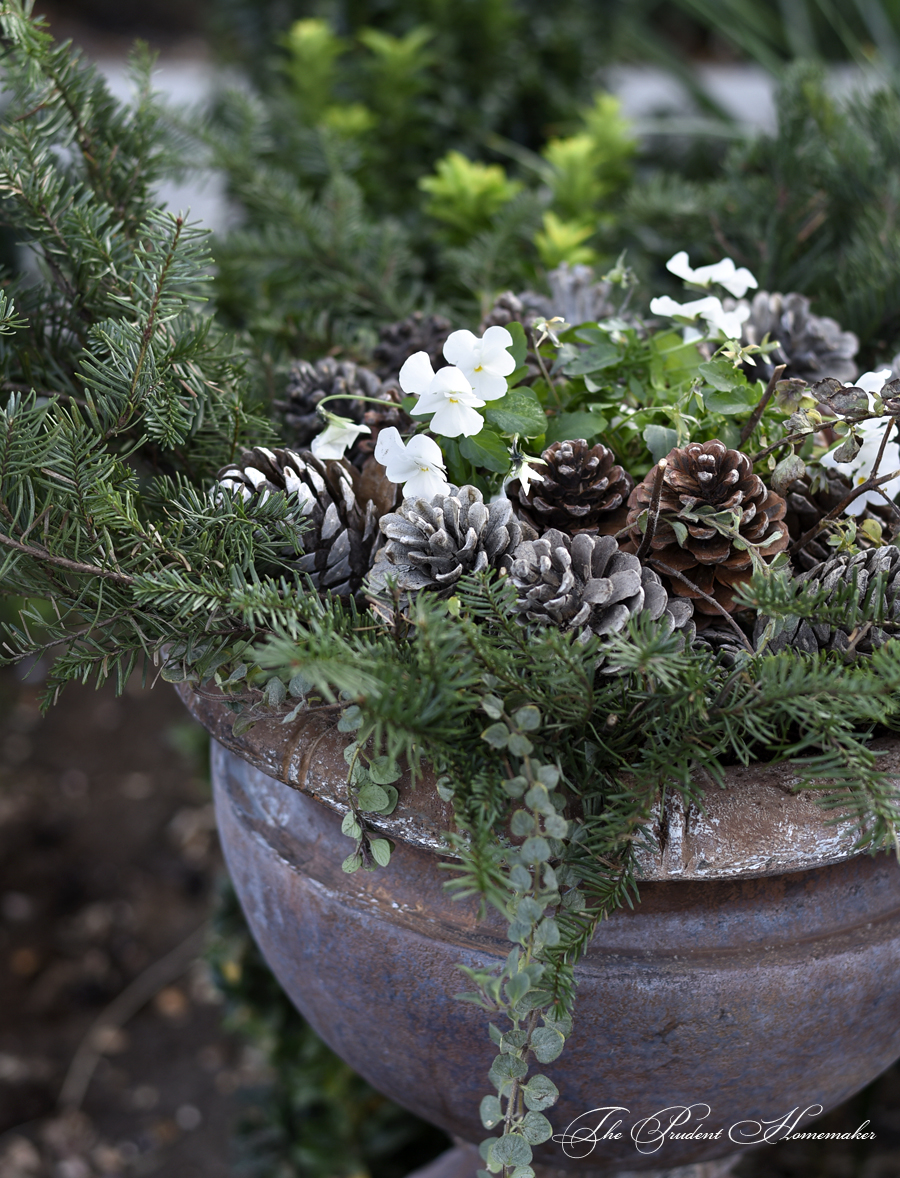
Earlier this year I added an urn (that I got for free) at the end of the low wall that I built. I dug up some oregano that had grown from seed in the garden and moved it into that urn. I added 2 viola plants that had been growing in the center urn. I then added some Christmas tree branches and some pinecones. Should the ornamental cabbage get too large for the center urn in the months to come, I may move them to this urn.
We still haven’t had a frost here, but all of these plants will do just fine with a frost. Other good choices for our mild winters that are also on sale are snapdragons, pansies, and violas.
Snow is extremely rare here, and frosts are short-lived: Our official first frost date is November 15th (but I usually don’t see a frost until mid-December) and our last frost date is February 15th, though I have rarely seen a frost past the third week of January. These plants should last until sometime in April.
My next plan in the white garden is to plant the daffodil bulbs that I’ve been chilling in the refrigerator for weeks. In our mild climate, prechilling helps to get the bulbs the chilling hours they require in order to flower. I won’t dig them up in years to come, however.
After Christmas, I’ll be pruning the roses and stripping any remaining leaves to force them into a short dormancy, which will make them stronger and healthier in the year to come. The white garden will then be empty of flowers except for the flowers in the urns until the bulbs start flowering and the roses flower again, sometime in late February at the earliest (and possibly not until mid-March).
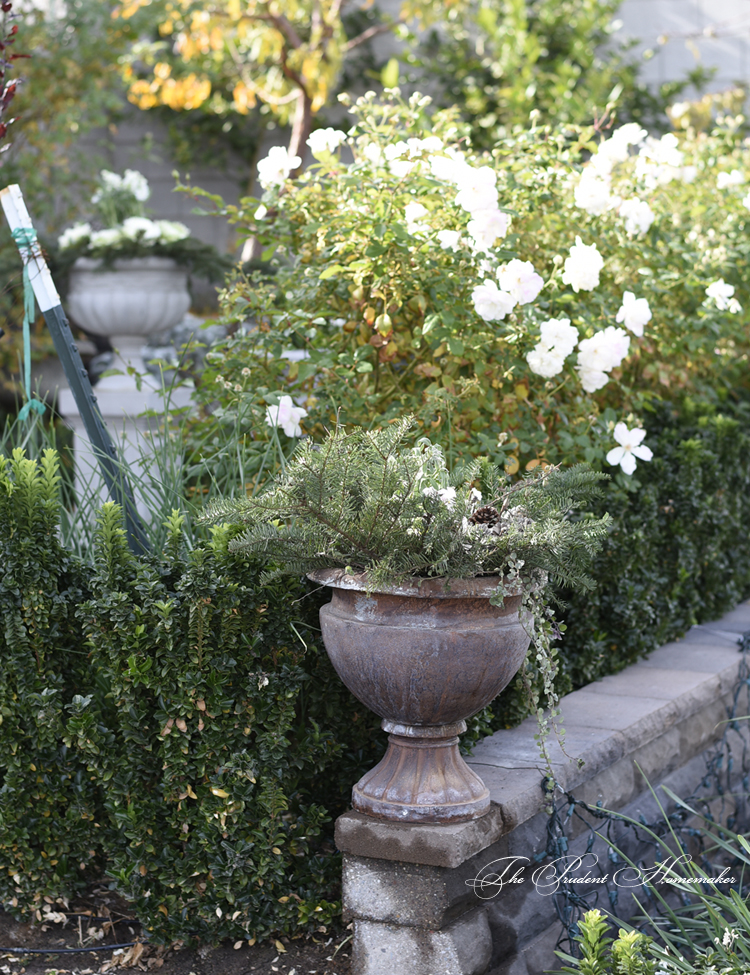

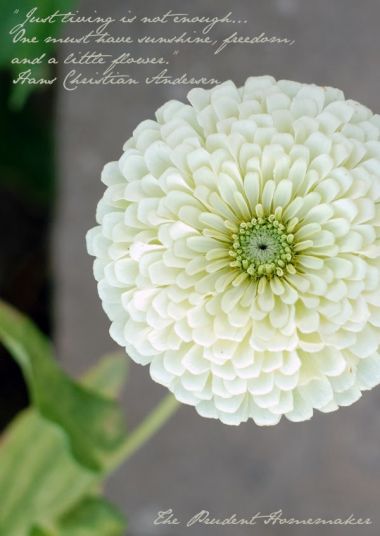
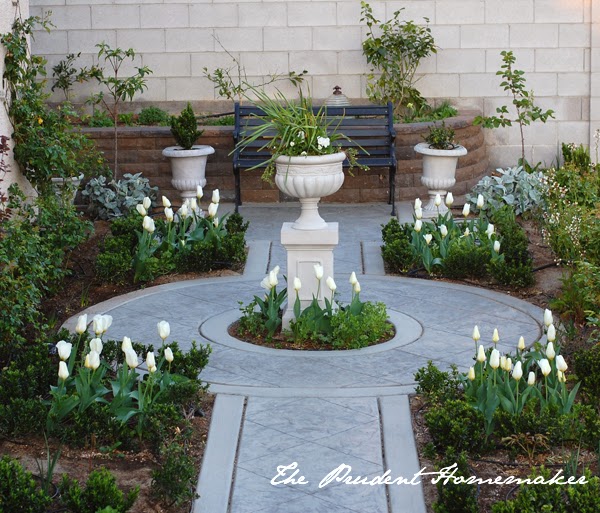
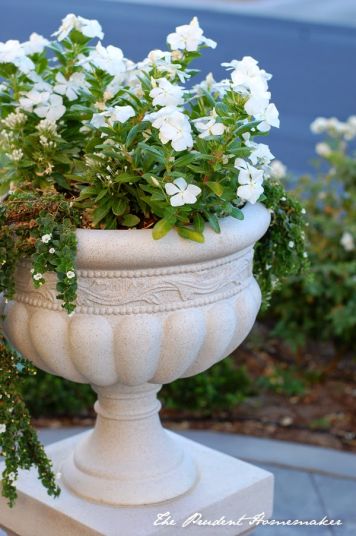
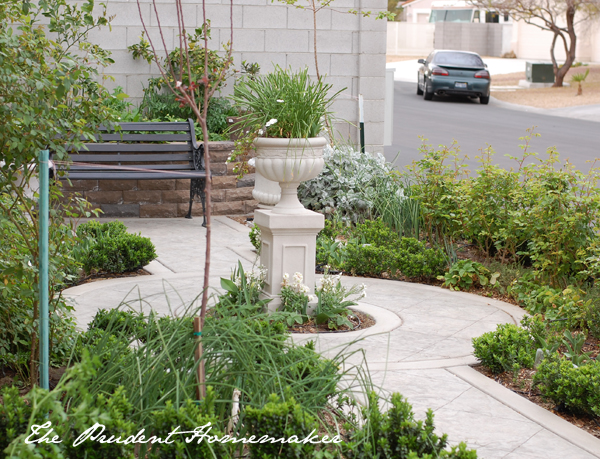
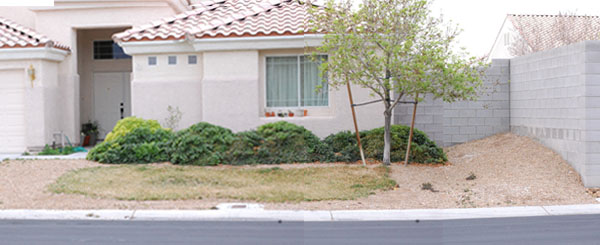
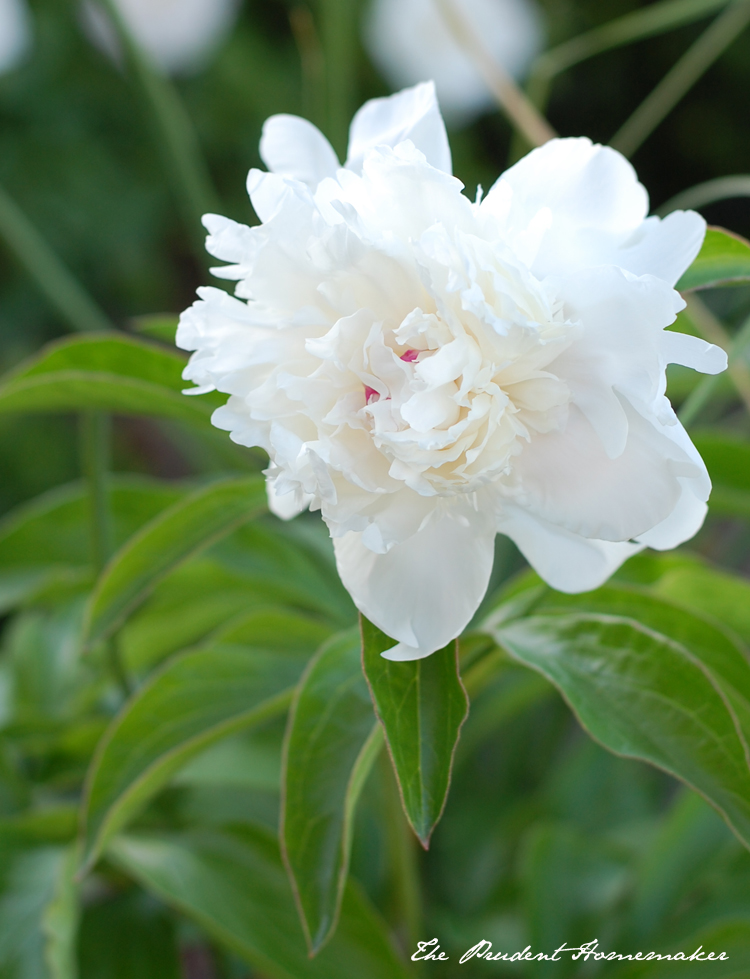
Each is so beautiful! I love the added free greenery, the pinecones, the cyclamen and the cabbages. Great Job!
You were so lucky to get a free urn! Where did you get the others?
I have some variegated ivy in a pot in my house, and while I was reading this post, I wondered if it would do well where you live. While not white flowers, the flecks of white in the leaves are pretty. I tend to think it would not like direct sun, but perhaps there are places in your garden it would do well…and you could always root cuttings to expand if you like. Your gardens are so lovely – thank you for sharing them! 🙂
Wow! Beautiful! Your prices are great, too!
I am amazed at the thought of flowers practically year round. My snapdragons were still blooming until the snow covered them up a day or two ago–even my husband, who is garden-challenged–noticed and commented on how hardy they are. He, who knows the names of maybe four flowers, mentioned snapdragons by name!! They winter over quite often, and we have prolonged snow cover and below freezing temperatures for weeks on end.
I love the look of your urns–my own efforts are considerably more “casual”–and usually about two years behind my plans besides. Thanks for sharing.
So beautiful!!
If I plant more of these plants in the garden, and some snapdragons, I will have flowers year-round. I’ve done snapdragons, stock, and violas in the ground in the past.
I was late getting any seeds in for violas in the white garden this year, but it’s so warm this week that it may be warm enough for me to plant them anyway!
Laura,
I like ivy and have considered putting in the pots by the front door, as it does well in shade. However, my husband is terrified of having it! Because of the way in which ivy grows, it can tear apart a stucco house (which ours is). I thought it would be nice in a planter, but he’s still doesn’t want it. I think it looks nice grown in a planter over a topiary form as well. It will grow here, but I think it would burn if it wasn’t in full shade. A lot of plants will do that here.
I have tried boxwood in the pots by the front door, and even those didn’t make it 🙁 Plants do need some sunlight. I can, thankfully, move the urns out further, and I do on occasion when I am working in the garden, to give them some sun.
Those planters are absolutely lovely. I love the mixture of textures and colors in them.
I’m terrified of ivy as well. In a house we lived in years ago, there were many trees adjoining our property that were being choked out by ivy. Now, in this new house, there is ivy growing everywhere and I have already done some removal, and have noticed several areas where I am going to have to get at it in the spring or it will be taking over. It’s so hardy and invasive here. It might be easier to tame down other places.
Brandy, you do such beautiful work. The urn by the door is my favorite. I really enjoy these posts on how you do what you do and are mindful of what is spent and have it look like something I would see at a botanical garden. I surely don’t get that message else where. You are so talented.
The free one came from a house where the previous owner had died, and all of the stuff was being hauled off to donate. I asked what was being done with it and was told that I could have it.
The ones by the door (and also the ones by the bench that have bushes in them, but are larger) came from Target, bought on 50% off clearance at the end of the season. Those were $10 each; the larger ones by the bench were $20 each.
The center urn and plinth were two different colors; one was from Lowe’s and the other from Home Depot. We painted them to match. They carry similar items still. We put a metal rod through both of them to keep the urn from being knocked off.
The urns looks lovely with winter plantings. I try to be thankful for what I have but am feeling a tad envious of your garden today. We have lovely white snow and below zero temperatures here in Minnesota this week. Time to plan my spring garden!!
I just love seeing the new pictures of your white garden. Look how far you’ve come with it!! Amazing.
Love reading how you find the best deals for your garden. Another inspiration! Thanks again for all your hard work in maintaining this blog.
Brandy,
These are so lovely!
My mother buys English ivy, the houseplant kind, to put in her annual pots in the summer here. They grow much slower and doesn’t seem to be invasive. Of course, they die off as soon as our cold weather sets in. I’m not sure if these would work in your warmer climate, but you might be able to do some research on it to find out.
I love the look of English ivy as well, but I have refrained from planting it not only because it can be invasive and destructive, but snakes love to hide in it. That’s life in Louisiana. I substitute confederate jasmine. And you are right on the money with those pots and urns. You can’t go wrong with the rule of three…filler, spiller, thriller….
Pretty with the tree trimmings. The white makes them look like there could be a little snow in the urns.
Our whole life is white with snow right now. The green of your urns is soothing to my eye. Thank you.
I love hearing about your white garden. I love that a person that is so busy and who has so many responsibilities has made the time to make and keep something whose main purpose is to be beautiful. Because beautiful things make a difference too. Thank you for sharing it with us.
I love that you have made it productive too, so that it helps feed your family.
Just signing on to your blog – just found you!